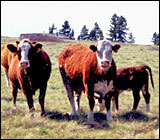|
Performance Reporting
Core Business Area 5: Risk Management

Goal 5: Stable farm incomes for British Columbia farmers.
Outcome: Stable farm incomes through programs that effectively minimize the impact of unpredictable, uncontrollable risks for B.C. farmers.
Weather hazards, natural disasters, diseases, pests and erratic markets can cause losses and lead to income instability in specific commodities. The ministry is fostering a shared-risk management approach with programs that stabilize these fluctuations so farmers can continue operating through downturns and remain competitive. This approach helps industry avoid significant income variability and the need for ad hoc government responses.
| Measure |
Baseline |
2003/04 Target |
2003/04 Actual |
| Stable farm incomes as measured by annual deviation from 5-year rolling average |
Farm cash receipts $2.21 billion (2001) which was 13.75% above the previous 5-year rolling average |
Reduced negative deviation from 5-year rolling average |
Target achieved:
Positive deviation. 2003 farm cash receipts at $2.31 billion which is 13.3% above the 5-year rolling average. |
Objective 1: A system of basic protection for farmers from uncontrollable and unpredictable disasters such as weather hazards, natural disasters, disease, pests and erratic markets consistent with trade obligations.
Strategies:
- Maximize federal funding offered to B.C. farmers through negotiations on the APF so that the combined federal/provincial investment provides a fair and effective level of support for risk management.
- Engage the private sector through partnerships or improved linkages to increase the range of risk management tools available to farmers in B.C.
- Make adjustments to the Whole Farm Insurance Program, Net Income Stabilization Account, and Crop Insurance in order to meet reduced budget targets over three years.
Performance Measures and Results
Performance is measured by examining the extent to which farmers are participating in risk management programs by comparing the total value of insurable crops to the total value of these same crops that are covered by some form of risk management (insurance) product.
| Measure |
Baseline |
2003/04 Target |
2003/04 Actual |
| Levels of participation in risk management programs — as measured by per cent of value of insurable crops covered by insurance |
30 – 70 per cent (varies by crop) of value of insurable crops covered |
Progress toward 2005/06 target (70 per cent of the value of all insurable crops covered by insurance/ programs) |
On target:
Sign-up for coverage (number of farm businesses that have coverage) in 03/04 is comparable to 02/03
The value of crops covered has increased |
Activities Related to this Objective:
| Implementation of the Canadian Agricultural Income Stabilization Program |
B.C. is among the first provinces to make the CAISP available (including interim payments in response to BSE), following a smooth wind down of the Whole Farm Insurance Program.
The ministry played a lead role in developing proposed linkages between CAISP and crop insurance so that B.C.'s need for cost-effective catastrophic coverage was not compromised. |
| BSE response |
The ministry helped design, negotiate and deliver three BSE-related support programs in partnership with the federal government (and on a stand
alone basis), securing approximately $70 million for B.C. ranchers and related farmers (BSE Recovery Program, Cull Animal Assistance Program and Market Steer and Heifer Transition Program), and interim payments through the CAISP.
|
| Crop Insurance program data |
2002/03 |
2003/04 (Target) |
2003/04 |
| 2002 crop year |
2003 crop year |
2003 crop year |
| Premiums |
$14.7 million |
$15.5 million |
$15.2 million |
| Value of crops covered |
$262.0 million |
$265.0 million |
$278.0 million |
| Loss ratio of claims to premiums (10-year moving average) |
0.71 |
0.70 |
0.67 |
| Administration costs as a percentage of premiums |
17 per cent |
17 per cent |
16 per cent |

Objective 2: A policy framework for marketing boards that increases B.C.'s share of national allocations, provides better governance, improves market responsiveness, and encourages specialty products and further processing in B.C. over a three-year period.
Strategies:
- Implement the recommendations of the regulated marketing review completed in 2002/03.
Performance Measures and Results
A key measure of success is an increase in B.C.'s share of the total Canadian sales of supply-managed commodities. While B.C. accounts for 13.1 per cent of Canada's population, its relative share in the sales of some supply-managed commodities is often lower.
| Measure |
Baseline |
2003/04 Target |
2003/04 Actual |
| B.C.'s share of Canadian sales of supply-managed commodities compared to B.C.'s percentage of Canadian population (13.2 per cent), or as greater market demand dictates. |
Milk — 8.3%
Chicken — 15.7%
Turkey — 10.6%
Eggs — 12%
Broiler egg — 16.6% |
Gradual increase in market share |
On target:
Milk — 8.3%
Chicken — 15.8%
Turkey — 10.7%
Eggs — 12.4%
Broiler egg — 16.1% |
Activities Related to this Objective:
| Implementing the recommendations of the regulated marketing review |
Merged B.C. Marketing Board and Farm Practices Board into the B.C. Farm Industry Review Board.
Established (with the Board Resourcing and Development Office) a formal, merit-based process to recruit and appoint all commodity board chairs through order in council.
The Mushroom Marketing Commission is being wound up.
Conducting needs assessment in other non-supply managed sectors to determine any further changes required to facilitate the marketing of these products.
Under the direction of the BCFIRB, all supply-managed boards have undertaken a full review of their policies and programs with respect to specialty markets. Further work is required by BCFIRB and the ministry. |
|
